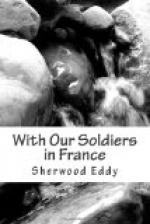Such is the effect of this new and latest triumph of modern science, which will shatter the hopes and happiness of thousands of homes.
After passing through the gas chambers, we visited the bombing section of the training school. Here each man has to throw one or more live bombs and receive his final coaching. The bomb is about the size of a lemon, and is made to break into small fragments. It contains enough of the high explosive to kill a whole group of men. The boy advances and grasps the bomb; he draws out the pin and holds down the lever. Once this is released, it explodes in just five seconds. The man heaves his bomb over a parapet at a dummy dressed in German uniform. The whistle blows and we all duck. There is a terrific explosion like a small cannon and you hear the pieces whizzing through the air. Every man is holding in his hand and wielding a terrible power. Wrongly used, it is death to himself and his comrades. The other day a boy’s hand was moist with perspiration and the bomb slipped, killing the group. Another prematurely exploded as it was being thrown, carrying away the man’s own hand and killing the instructor. So it is a dangerous business. During the morning there were only four “duds,” or bombs that would not go off.
After the bombing section, we pass with the men to the trenches. Bayonets are drawn and rifles loaded. After firing several rounds, comes the command, “Advance.” At a bound they are “over the top” and off, heads down; they run very slowly and keep together. A breathless man who outruns his comrades is useless and is soon killed by the enemy. The drill sergeant shouts to the men “Keep together, keep together, men, one man can’t take a trench,” and my friend the “padre” notes his words to tell to his congregation when he goes home, where the minister can’t do all the work. When they are near the enemy’s trench, the final word “Charge” is shouted, the whole line leaps forward with a wild yell, and the bayonets are driven into the stuffed sacks which are suspended as dummies to serve in the place of men.
For miles across the great plain the “Bull Ring” is alive with men. Here in one section they are doing physical drill and learning to go over all kinds of obstacles—trenches, fences, barbed wire, shell holes, and ditches. There they are practicing musketry and advancing under cover. In one place the artillery is in full swing, and in another you hear the sputter of the machine guns. In one section they are taught to dig trenches and in another to take them.
Before a great advance where a system of trenches is to be taken, a “rehearsal” often takes place. From a height of thousands of feet above the lines the aircraft with powerful telescopic cameras photograph every foot of the battlefield covered by the enemy’s lines. These photographs are developed and studied and diagrams drawn from them of the enemy’s system of trenches. These




